Fuchsia Dunlop's Blog, page 2
August 22, 2015
The delights of eating jellyfish
Vast numbers of jellyfish have been invading British beaches this summer, to the consternation of tourists and local people. Perhaps we should just find out which species are edible, and learn how to eat them?
The photograph shows a snappy little starter made from the oral arms of jellyfish (known in Chinese as ‘jellyfish head’ 海蜇头), as served with a seasoning dip at the Dragon Well Manor in Hangzhou. The ‘jellyfish’ most commonly served in Chinese restaurants in the West is the umbrella-like top of the creature, which the Chinese refer to as its ‘skin’ (海蜇皮).
Here’s a BBC interview I did about the pleasures of eating jellyfish:
July 10, 2015
A taste of Xi’an in North London

Biang Biang noodles in Xi’an
Though the Chinese city of Xi’an is best known for its terracotta soldiers, it also has some notable culinary specialities, including ‘soaked flatbread with beef or mutton’ (niu/yang rou pao mo) and sweet persimmon cakes. Since a tiny stall called ‘Xi’an Famous Foods‘ in a mall in Flushing, New York, blossomed into a chain of six casual restaurants, New Yorkers have been able to taste some of these, but until now the only place in London to serve some Xi’an food has been Chang’s Noodle, near the British Museum, which serves mainly food from Henan Province. Anyway, this week an old friend of mine, Chef Wei Guirong, has opened a sweet little neighbourhood snack shop in Holloway devoted to specialities of Xi’an, which is her hometown.

Gluten salad and cold wheatstarch noodles
Chef Wei is making all her own noodles, flatbreads and dumpling wrappers, as well as liang pi, which translates (somewhat unappetisingly!) into English as ‘cold skin’, but is actually slippery-fresh noodles made from steamed wheatstarch, served with slivered cucumber and chicken in a chilli-oil dressing (the wheat gluten is served separately in a salad).
The other night I dropped in with some friends for supper, and was
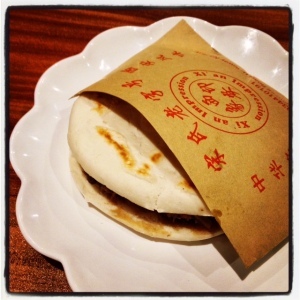
Xi’an ‘hamburger’ (rou jia mo)
delighted to be able to scoff fabulous flatbreads stuffed with the local version of pulled pork (la zhi rou); Xi’an potsticker dumplings with their typical open ends, and, here, a chicken and mushroom stuffing; and, of course, ‘soaked flatbread with beef’, a hearty soup-stew served with sweet pickled garlic, chopped coriander and a chilli relish. When we’d finished, we looked somewhat enviously at the Chinese people at a neighbouring table slurping up hand-pulled noodles – I’ll try them next time.
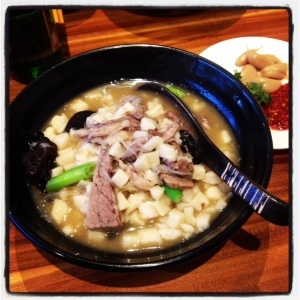
Soaked flatbread with beef (niu rou pao mo)
Incidentally, one of the dishes on the menu is Shaanxi biang biang noodles – which are renowned because their name is based on the most complicated of all Chinese characters. Above, you can see this character, in all its splendour, in a photograph I took of a restaurant sign in the old Muslim town of Xi’an.
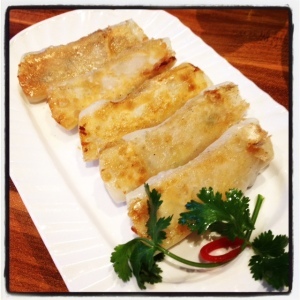
Potstickers – slurp
Chef Wei is yet another alumna of Barshu, the restaurant for which I work as consultant – continuing the tradition of Barshu functioning as a kind of Ivy League of Chinese chefs in the UK (Sichuan Folk in Hanbury Street and My Sichuan in Oxford are among the restaurants run by former Barshu chefs; Xi’an Impression is also run by the Sichuan Folk folk).
Xi’an Impression, 117 Benwell Street, N7 7BW
Tel: 0203 441 0191
April 16, 2015
Fortnum and Mason Food and Drink Awards shortlist
How lovely to be shortlisted for Food Writer of the Year by the Fortnum and Mason Food and Drink Awards, along with the excellent Sybil Kapoor and Tim Lewis!
January 30, 2015
Eating animals to extinction
The seamy side of Chinese gastronomy was in the headlines again this week, as fourteen police officers in Shenzhen were suspended and a police chief put under investigation on suspicion of eating a giant salamander. You can here my thoughts on it here. And here is a pic of this extraordinary creature, which is known in Chinese as a ‘crying baby fish’ because of its call (wa wa yu 娃娃鱼)
November 7, 2014
My latest WildChina food tour
In October, I took another group of adventurers on a gastronomic tour of China, from Beijing, through Xi’an, Chengdu and Hangzhou, to Shanghai. It’s always a delight, for me, to see everyone expanding their food horizons in ways they perhaps hadn’t anticipated. In particular, I’m happy when guests really begin to appreciate the importance of texture in Chinese cuisines – and, in many cases, to positively enjoy eating delicacies such as sea cucumber and goose intestines, which are largely incomprehensible in terms of European/American gastronomy. If any of this year’s guests are reading this post, thanks again for your openness and enthusiasm!
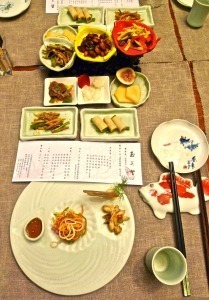
Dinner at Lan Guijun’s Yu Zhi Lan in Chengdu
During the tour, we ate at many different kinds of restaurant, from tiny holes-in-the-wall to the splendour of the Dragon Well Manor in Hangzhou, visited food markets and took a Sichuanese cooking class. Oh, and there was a bit of sightseeing too – the Forbidden City, Terracotta Warriors and that kind of thing…
After the main tour, I spent a week in Yunnan on a reconnaissance mission for next year’s inaugural Yunnan food tour. Both 2015 tours are already sold out, but I believe WildChina will be opening bookings for 2016 in the next month or two.
November 6, 2014
Swedish adventures
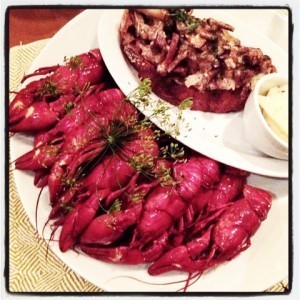 We pulled the crayfish apart, sucking the juices from their heads and chomping through the claws, devoured their sweet flesh, deeply infused with the flowery scent of dill. Our hands ran with salty juices; occasional spurts hit our hair and clothes. We had at least a dozen crayfish each, maybe more, all of them red as fire engines, the females plump with golden roe. They were served with another seasonal treat, chanterelles, slick with cream and speckled with parsley, on sourdough toast, and a Swedish cheese flavoured with cloves and caraway. My dining companion was supposed to be interviewing me for a Swedish newspaper, but by the time the crayfish arrived, civilised conversation was impossible. I was glad I hadn’t had time to change my clothes before dinner.
We pulled the crayfish apart, sucking the juices from their heads and chomping through the claws, devoured their sweet flesh, deeply infused with the flowery scent of dill. Our hands ran with salty juices; occasional spurts hit our hair and clothes. We had at least a dozen crayfish each, maybe more, all of them red as fire engines, the females plump with golden roe. They were served with another seasonal treat, chanterelles, slick with cream and speckled with parsley, on sourdough toast, and a Swedish cheese flavoured with cloves and caraway. My dining companion was supposed to be interviewing me for a Swedish newspaper, but by the time the crayfish arrived, civilised conversation was impossible. I was glad I hadn’t had time to change my clothes before dinner.
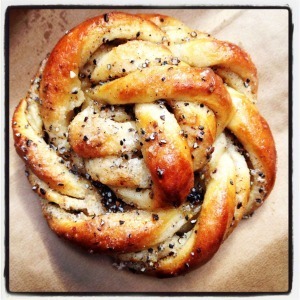
Cardamom bun
The crayfish (at Taverner Brillo) were probably the most traditional Swedish dish I had during my trip in early September, my first visit to the country. I was there to give a lecture and cooking demonstration at Restaurangakadamien, and the organiser, food-writer Lisa Forare Windbladh, had drawn up my extra-curricular itinerary for Stockholm. In Malmo, I was lucky enough to be under the stewardship of the founders and editors of Fool magazine, Per-Anders and Lotta Jorgensen. So apart from the hotel breakfasts of cinnamon buns, gravlax, liver pate and – my new addiction – soft-boiled eggs with salty ‘caviar’, I was mostly tasting my way through what has come to be called New Nordic Cuisine.
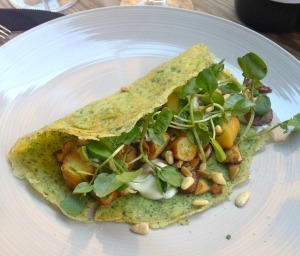
Herb gallette at 19Glas
On my second day, Lisa took me shopping for Chinese ingredients for my class, with a detour to the Hotorgshallen covered market, where we sampled sea buckthorn and cloudberry jams, liquorice and charcuterie. At Hav, fishmonger Per-Anders Bergqvist plied us with herrings of many colours, jewel-like vendace roe, cheese and schnapps. At 19Glas, a wine bar devoted to natural wines, we had the set lunch menu: the highlight a superb ‘herb galette’, spinach-green, filled with roasted parsnip and mushrooms and served with smoked crème fraiche and toasted pine nuts.

Divine lamb at Gro
After a crazy day of talking, teaching and cooking a Sichuanese supper for 40 people at Restaurangakadamien, I was back on the Swedish food trail. A friend of Lisa’s took me for lunch at a new, tiny, bistro called Gro where I had one of the most quietly memorable meals of the trip. Gro is run by two young chefs who toil away, softly and intensely, in an open kitchen. There are just a handful of seats (no reservations), and the menu consists of three dishes and a dessert chalked up on a blackboard. The golden sunrise of a salad – shaved fennel and carrot on a bed of carrot puree, with toasty sunflower seeds – was beautiful enough, but the lamb took my breath away. Simple, but perfectly harmonious, the lamb shoulder had been slow-cooked in beer, and was then spooned over softened chunks of carrot and celeriac and dressed in ravishing, creamy sauce spiked with vinegar, with a slug of yellow rapeseed oil, chopped chives and sprigs of fennel. It was the kind of lunch that leaves you on a cloud.
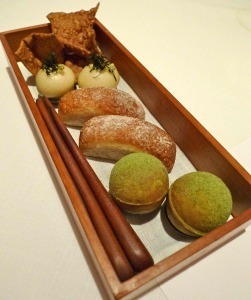
‘Bread’ is an understatement – Esperanto
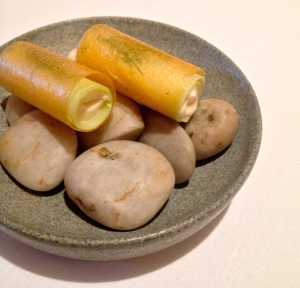
Ethereal cooking at Esperanto
One evening, Lisa took me to Esperanto, run by Sayan Isaksson, a Swede of Korean extraction. Less well known that some other avant-garde restaurants, it won the accolade of 2013 ‘Restaurant of the Year’ from the White Guide, the Swedish Who’s Who of restaurants. It’s not often you can say that the bread was a highlight of a tasting menu, but here it was: crispbreads darkened by soy and pig’s blood, with the crisp-crumbly texture of fried wonton skins; divine steamed buns stuffed with kale; muscular little loaves of white sourdough; golden spheres of fluffy, cake-like bread coloured green by ramsons. The other dishes were equally amazing. A green plate of buttermilk cheese camouflaged by powdered chives, with onion flowers and deep-fried lichen was served with ‘potato crisps’ for dipping. Fragile spheres of frizzy deep-fried swede yielded to reveal a briny oyster cream. We used mother-of-pearl spoons to scoop out the golden, waxy yolks of quail eggs aged in miso and covered in a froth of jerusalem artichoke. It was the kind of elfin, esoteric, complex fusion food that is so difficult to get right, but this was perfect. Astonishingly good, actually.
In Malmo, I met chef Andreas Dahlberg over an aperitif at his restaurant, Bastard (‘It’s a terrible name,’ he said, ‘but you get used to it, like “The Cardigans” for a band’.) Like almost everyone on the Swedish food scene, he was a human canvas, with elaborate tattoos covering his arms. After a while he had to leave, but I stayed on for supper. The food here is mainly local, and produce-driven. There was a duck eggyolk that spilled like golden lava over a bed of wild mushrooms, surrounded by a fairy ring of mustard seeds; crabmeat spiked with chilli and served with kale. The highlight of the feast was a piece of tender cod with mussels, hot cucumber and nasturtium blossoms in a pale golden sauce with a delicious edge of acidity.
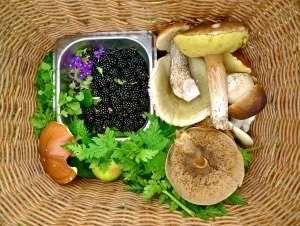
Foraging at Talldungen
Another day, Emma, the chef-patron (with her husband David) of the Talldungen restaurant and guesthouse, took us foraging around the pinewoods near her home. We filled a basket with ceps, portobellos and other mushrooms, blackberries and wild greens: it was one of the richest mushroom seasons anyone can remember, and they were springing up everywhere, edible and inedible (we left the gorgeous, sinister fly agarics, as you can imagine). Afterwards, Emma and David fed us with home-grown tomatoes followed by porchetta, the mushrooms we’d picked, sauteed in butter, and a salad of foraged greens.
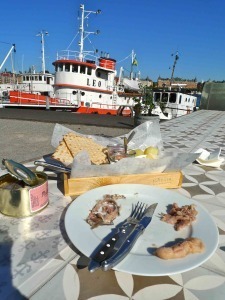
Stinky surstromming
As regular readers of my writing will know, I’m fascinated by stinky foods, so I was thrilled to have the chance to eat the infamous surstromming (fermented herring) in Sweden, in the right season. I had tasted it once before, at the Oxford Food Symposium, when someone brought a tin, and as soon as she pierced it everyone stood back at the stinkbomb vapour. This time, I was able to eat it properly, with all the trimmings, on the shore of the Skeppsholmen Island in the centre of Stockholm, thanks to Chef Malin Sodersterom. Malin mentioned that she was having a surstromming dinner that night, and she must have noticed that my eyes lit up, because she offered me a preview. So she came out of her kitchen with a tray holding a tin of stinky fish, sliced potatoes, butter, chopped onion and crispbread, and instructed me on how to make an open surstromming sandwich. First, there was a sharp exhalation of putrid gases when she opened the tin to reveal the silvery, puce-coloured fish. The herrings had the salty, umami taste of anchovies, accompanied by those foxy, armpit odours – it certainly had echoes of Shaoxing rotted amaranth stalks. The bright piquancy of the onion set it off nicely.
Just a few highlights of a fantastic trip…
With thanks to Majo, Visit Sweden, FOOL magazine and all the local food people who gave me such a warm welcome.
For readers of Swedish (or users of Google Translate!), here are a few accounts of my Sichuan food workshop in Stockholm:
A piece by chef Anders Johannsen
Anna Lind Lewin (aka Mrs Food) blog post
October 10, 2014
The MSG controversy
If you’re paranoid about eating MSG, or just interested in the subject, you might like to listen to this American PRI discussion in which Dr Katharine Woessner explains the lack of scientific evidence against MSG, and I talk from a Chinese culinary point of view:
http://www.sciencefriday.com/segment/...
And in other developments (!), here’s Diane Leach of PopMatters using my books as the gateway into the mysterious delights of Sichuan pepper:
September 16, 2014
Endangered sharks
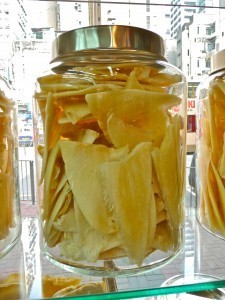
Shark fins for sale in Hong Kong
I was very interested to see this article on the Guardian website, highlighting the threat to sharks from tuna fishing. Basically, enormous numbers of sharks are being killed as ‘bycatch’ in the course of tuna fishing in Indonesia. Their valuable fins are sold onto the Chinese market, according to the article, while their meat is eaten locally:
“The shark are technically bycatch, but they’d be more accurately described as valuable byproduct. And the sheer numbers being caught are shocking. Even more alarming is the fact that all three of the shark species mentioned above are on the IUCN’s red list of endangered species.”
I have wondered for some time how many sharks were killed as bycatch, because it throws an interesting light on the campaign against eating shark’s fins: i.e. that it’s not just the Chinese appetite for fins that is jeopardising shark species, but destructive fishing practices in general. However, when I interviewed an expert from a major environmental organisation about the fin trade, he seemed reluctant to discuss it. I wondered at the time if this was because any evidence of large numbers of sharks being killed as bycatch might detract from the black-and-white clarity of the campaign against the Chinese fin trade…
So, as I’ve said before, it’s not just the Chinese who are eating the world to extinction – most of us are just as bad. And while the custom of eating shark fins is conspicuously destructive and therefore an easy target for moral indignation, we also need to look broadly at the damaging consequences of the modern Western diet.
Meanwhile, on a happier note, the Convention on International Trade in Endangered Species (CITES) has blacklisted trade in five species of sharks, and manta rays. And, as the Guardian article mentions, there does seem to be evidence that eating shark’s fin is on the decline in China. Anecdotally, I’ve heard from countless people in the Chinese hospitality business that expensive dining-out has been hit hard by President Xi Jinping’s anti-corruption campaign, and that demand for luxurious delicacies is waning for this reason.
July 29, 2014
The threatened pangolin
 The pangolin, or scaly ant-eater (chuan shan jia 穿山甲), is an extraordinary creature. Plated in armour-like scales, it looks like a pine cone (or a stylised carp – if you just look at the scales – which is why one of its Chinese names is ling li 鲮鲤). Unfortunately, it’s now being eaten to extinction – and you can guess who is to blame. Yes, it’s the Chinese, along with the Vietnamese. Their relentless appetite not only for the flesh of the pangolin, but for its scales, a traditional medicine, is driving an illegal trade in pangolins from Africa and Asia. According to the newly-updated IUCN List of Threatened Species, the pangolin is now the most illegally-traded mammal in the world, and all eight pangolin species are threatened with extinction.
The pangolin, or scaly ant-eater (chuan shan jia 穿山甲), is an extraordinary creature. Plated in armour-like scales, it looks like a pine cone (or a stylised carp – if you just look at the scales – which is why one of its Chinese names is ling li 鲮鲤). Unfortunately, it’s now being eaten to extinction – and you can guess who is to blame. Yes, it’s the Chinese, along with the Vietnamese. Their relentless appetite not only for the flesh of the pangolin, but for its scales, a traditional medicine, is driving an illegal trade in pangolins from Africa and Asia. According to the newly-updated IUCN List of Threatened Species, the pangolin is now the most illegally-traded mammal in the world, and all eight pangolin species are threatened with extinction.
A few thoughts on this:
1. I believe eating pangolins is mainly a southern, Cantonese habit. A Chinese friend told me today that she’d been offered it at a banquet hosted by rich acquaintances in Shenzhen (she refused). Personally, I’ve never come across pangolins in Chinese kitchens or on Chinese dinner tables, although I’ve met chefs who have cooked them. One culinary encyclopaedia I checked says the meat is tough and coarse, but can be casseroled, stewed or stir-fried.
2. The vast majority of Chinese people will never come across pangolins. Rare creatures like these are extraordinarily expensive, and tend to be eaten secretly, in the private rooms of exclusive restaurants. The problem is that the number of rich people who want to eat them, and can afford to do so, has risen rapidly since China’s economic development really kicked off in the early 1990s, with catastrophic results for pangolins and other edible wild creatures worldwide. Serving a rare creature for dinner can have some of the same social cachet as cracking open a bottle of fine vintage wine in London, and creatures regarded as medicinal tonics are particularly prized. There is a lucrative illicit trade in protected species, and certain chefs know how to obtain them, with a bit of notice, when a guest puts in a particular order. Cooking and serving them can be hugely profitable for restaurants – there’s a big mark-up, as there is with wine in restaurants in Europe.
3. Campaigning against pangolin-eating is more complicated than campaigning against shark’s fin-eating. It’s relatively easy to shame big hotel chains and companies such as Disneyland into taking shark’s fin off their menus, because it is legal and openly eaten. With illegally-traded delicacies such as pangolin, no one is eating them openly anyway – it’s all underground.
4. Chinese people tend to dislike sanctimonious Westerners telling them what to do, particularly on environmental issues, where they can argue quite reasonably that the West is just as bad, if not worse, than China. And although deliberately eating endangered creatures may be a (minority) Chinese habit, we are driving all kinds of creatures towards extinction by our broader behaviour – look at the polar bear, whose habitat is being destroyed by climate change, for just one example.
5. On the other hand, Chinese people, especially younger ones, can be sensitive to their international image. In particular, the Chinese do not want anyone to think they are ‘backward’: ‘backward’ (luo hou 落后) is a terribly pejorative term in Chinese. It’s interesting that there seems to be a groundswell of opinion against eating dog meat, which has a long history in China and which is not (in my opinion) necessarily worse than eating pigs, mainly because of the Western view that eating ‘man’s best friend’ is barbaric. Could a campaign about the barbarism and ‘backwardness’ of eating endangered species ultimately dent their appeal for socially aspirational Chinese nouveaux riches?
You can hear me taking part in a discussion about the pangolin issue on today’s podcast of World Update, BBC World Service Radio – link here.
July 23, 2014
Les Chefs des Chefs… in London
 A rather incredible evening on Monday… At short notice, I was invited to a dinner at Mosimann’s for a gathering of the Club des Chefs des Chefs – an elite association of chefs working for heads of state around the world. The reason: so that I could accompany the Chinese delegation, who might otherwise have felt stranded in a sea of non-Chinese-speakers. It was surreal and wonderful to meet the chefs in charge of the kitchens at the White House and Buckingham Palace, as well as the chefs attendant on the King of Thailand and the Irish President, among others. Interestingly, the Chinese delegation were not the personal chefs of the Chinese President, but two of a team of thirty-something culinary experts from all over China who produce state banquets at the Great Hall of the People in Beijing. (Visiting heads of state do not stay in the Chinese president’s official residence while in Beijing, but in the Diaoyutai State Guesthouse, and we know nothing about the Chinese president’s private catering arrangements.) It was fascinating talking to the Chinese chefs, who were originally from Jiangxi and Liaoning (they and their colleagues take it in turns to attend the Club’s international events), and also a pleasure to be able to make them feel more at home.
A rather incredible evening on Monday… At short notice, I was invited to a dinner at Mosimann’s for a gathering of the Club des Chefs des Chefs – an elite association of chefs working for heads of state around the world. The reason: so that I could accompany the Chinese delegation, who might otherwise have felt stranded in a sea of non-Chinese-speakers. It was surreal and wonderful to meet the chefs in charge of the kitchens at the White House and Buckingham Palace, as well as the chefs attendant on the King of Thailand and the Irish President, among others. Interestingly, the Chinese delegation were not the personal chefs of the Chinese President, but two of a team of thirty-something culinary experts from all over China who produce state banquets at the Great Hall of the People in Beijing. (Visiting heads of state do not stay in the Chinese president’s official residence while in Beijing, but in the Diaoyutai State Guesthouse, and we know nothing about the Chinese president’s private catering arrangements.) It was fascinating talking to the Chinese chefs, who were originally from Jiangxi and Liaoning (they and their colleagues take it in turns to attend the Club’s international events), and also a pleasure to be able to make them feel more at home.
The dinner, prepared by Chef Jerome Henry and his team, was designed as a showcase of British produce: starters of chicken liver and truffle parfait, smoked salmon and Devon crab roulade, hand-dived Scottish scallops; then Anton Mosimann’s famous mushroom risotto (delicious); seared lamb loin with braised lamb shoulder; a selection of cheeses; almond tuile with summer berries; coffee and petit fours. I’m happy to report that the Chinese delegation, who deal with ‘Western food’ as well as Chinese regional cuisines in the course of their professional catering lives, enjoyed the food, especially the risotto and the braised lamb shoulder, which reminded them of Chinese red-braising techniques – although I noticed they were less excited than me about the delicious oozy, smelly cheeses.
You can read more about the Club’s activities in London here and here.
Fuchsia Dunlop's Blog
- Fuchsia Dunlop's profile
- 392 followers




